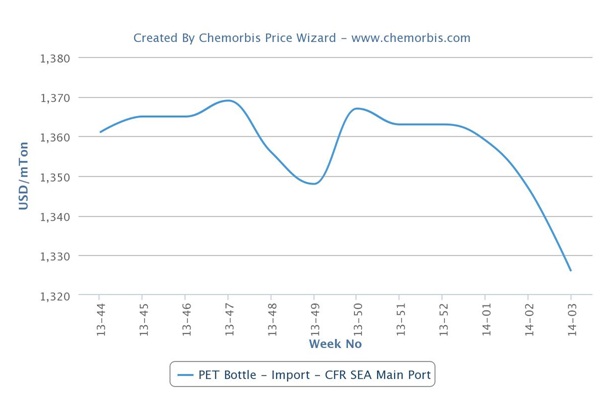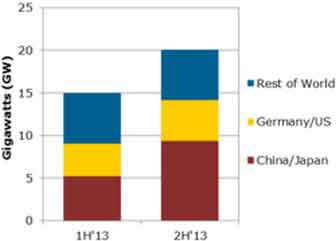Crude oil’s price rally has helped drive gains in Asian petrochemical values this week but the trend may quickly reverse as much of the increase was due to a sudden shift in sentiment rather than demand recovery, industry sources and analysts said on Friday. A significant portion of the crude price rise since late last week can be traced directly to optimism about the US economic recovery following government measures aimed at providing more financial aid to its ailing companies, and at ridding its banking system of toxic assets, analysts said. Investors braved the world equities markets while others turned to commodities like oil, allowing prices to break the $40-50/bbl (€29.6-37/bbl) range seen since the start of the year.
“It remains uncertain whether this rally over the past week is sustainable. It was primarily driven by the financial and equities rally and is very much vulnerable to downside,” said Victor Shum, analyst at energy industry consultancy firm Purvin & Gertz. There was a slight pullback in prices after crude hit a new high for this year on Thursday. At 12.00pm (05:00 GMT), NYMEX light sweet crude for May delivery was down 47 cents at $53.87/bbl while Brent crude also fell 46 cents to $53.00/bbl after hitting new highs for the year on Thursday. Prices of Asia’s petrochemical products have been rising primarily due to the cost-push effect of rising crude, along with some firming up in demand and sentiment, market sources said.
A polystyrene (PS) processor in Dubai said he had been able to settle May contracts with customers at relatively high levels due to rising crude and styrene feedstock values.
“I myself purchased 400 tonnes of high impact PS (HIPS) this week at $1,100/tonne CFR (cost and freight) Dubai for April shipment. This was $80/tonne higher than my purchases last month, but I was willing to accept the high PS prices because sentiment is improving along the chain, from styrene down to finished goods,” he said. In India, polyethylene (PE) suppliers raised offers for linear low density PE (LLDPE) to $1,020-1,040/tonne CFR India as sentiment firmed up on the back of higher crude values and tight supply.
“We are seeing much better buying activity this week than last week, despite the fact that purchases are usually scant ahead of the end of the financial year on 31 March, and this is largely due to the positive effect of crude,” said a Mumbai-based trader. In the case of methyl methacrylate (MMA), the rise in crude values has been putting brakes on further price declines, said a northeast Asian producer. “Base oil prices have stopped falling in the key Chinese market as a result of firmer crude as well as curtailed runs at many of the countries refineries,” said a northeast Asian base oils seller. For refinery products like base oils, the margins available to producers have tightened after the increase in crude prices and the consequent surge in gas oil values over the past few days.
This has helped firm the sentiment and those who were buying on a need-to basis until now seem more amenable to purchases to build inventories, said base oils buyers and sellers. But the uptrend in crude prices is not all good as it will continue boosting feedstock prices and raise the cost of producing petrochemicals. Polymer producers in India were concerned about the prospect of a margins squeeze if crude continues to rise, prompting a rise in ethylene, propylene and styrene costs. “Right now, we are using styrene feedstock which we purchased a month ago, when prices were much lower, so margins are quite good,” an Indian PS producer said. “However, we will feel the pinch when our inventories dry up and we have to buy high-priced styrene next month,” the producer added. Before the surge above $50/bbl in the past two weeks, crude futures were trading at about $40/bbl levels, supported by OPEC’s production cuts.
“The supply-demand fundamentals in oil have not really changed much. One might argue that fundamentals may have actually weakened given the much-larger-than-expected build in crude inventories,” said Shum.
Crude inventories in the US rose to their highest level since 1993 based on the weekly supply statistics from the Energy Information Administration (EIA). The same trend could be happening with the rest of the world as economies are in the throes of recession, which could be the worst since the Depression era of the 1930s. In countries like South Korea, which is beset by a very weak currency but relies 100% on imported crude, higher energy cost is a bane for its petrochemical industry. “Korea is a country with heavy imports of naphtha. If we have to buy naphtha at a higher price, then our cost price will go up,” said Im Jee Soo, analyst at South Korean brokerage Goodmorning Shinshan.
“In the current weak economy, it will be very difficult for Korea to sustain,” she said.
While Im expects crude oil to continue trending upwards in the next quarter, she said the actual impact on the country’s petrochemical industry may not be felt since most facilities throughout April and May will be shut for annual maintenance.
“Hopefully, by the time Korea’s petchem maintenance is over, somewhere in June, the crude oil price will be stable enough. If it is so, market conditions will improve,” Im said.
Purvin & Gertz’s Shum expects US crude futures to average close to $50/bbl this year, with some firm uptrend likely in the later part of 2009 when the economic stimulus packages implemented by governments across the world start to take root. Given the sharp rise in crude prices recently, some pullbacks are bound to happen, analysts said.
“Investors should not drop their guard and now think that oil price is on a smooth upward trend. Expect a bumpy ride. Some may pocket profits in the near term,” said Shum.
Source: nctww.com







